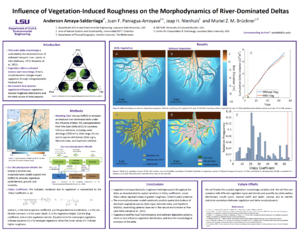2025 CSDMS meeting-084
From CSDMS
(if you haven't already)
Log in (or create account for non-CSDMS members)
Forgot username? Search or email:CSDMSweb@colorado.edu
Browse abstracts
Influence of Vegetation-Induced Roughness on the Morphodynamics of River-Dominated Deltas
Anderson Amaya-Saldarriaga,
(He/him),Louisiana State University Baton Rouge Louisiana, United States. asalda6@lsu.edu
Anderson Amaya-Saldarriaga, Louisiana State University Baton Rouge Louisiana, United States. asalda6@lsu.edu
Jaap Nienhuis, Utrecht University Utrecht , Netherlands. j.h.nienhuis@uu.nl
Juan F. Paniagua-Arroyave, Universidad EAFIT Medellín , Colombia. jpaniag2@eafit.edu.co
Muriel Brückner, Louisiana State University Baton Rouge Louisiana, United States. mbruckner@lsu.edu
First-order delta morphology is primarily governed by the dominant driver of sediment transport (river, waves, or tides), which dictates the overall sediment balance of the delta. Vegetation affects morphology through its influence on hydraulic roughness, introducing flow resistance, altering velocity distributions, and modulating sediment deposition. In turn, morphodynamic changes affect vegetation, creating a bio-geomorphic feedback-loop that results in a dynamic equilibrium, where the delta’s morphology and dynamic vegetation co-evolve over decadal timescales. This study examines how dynamic saltmarsh vegetation influences delta morphology in a river-dominated delta. We used Delft3D coupled with an ecomorphodynamic model to simulate the feedback-loop between dynamic vegetation and an idealized river-dominated delta, inspired by Wax Lake Delta, Louisiana. The ecomorphodynamic model simulates vegetation establishment, growth, and mortality resulting in dynamic variations of vegetation height and density that produce realistic hydraulic roughness distributions. Our findings demonstrate how vegetation-induced roughness variations can influence sediment redistribution and changes in bed elevation, affecting the morphology. This research highlights the importance of considering vegetation in morphodynamic studies, improving the understanding of delta systems.

